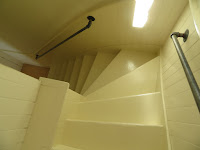Wolves have been featured as the bad character in children's stories, but kids certainly enjoy seeing the ancestors of domestic dogs. Why not let them howl with the wolves? You can make it happen by signing up for a Howl Night at Wolf Park in Lafayette, Indiana.
 |
| Wolf Park employee at Howl Night |
The program now costs approximately $12 per adult and $10 per child. We may have paid more because our program also included a hot dog campfire dinner. Our event occurred pre-COVID, so programs can change. The 1.5 hour program now includes 30 minutes to walk the grounds and see all the animals in enclosures, followed by a one hour howl program with an educational talk and staff demonstrating how they communicate with wolves. Everyone has an opportunity to howl from the stands. All fees and gift shop purchases go to a good cause. The Wolf Park operates as a non-profit and has a mission, dedicating the organization to behavioral research, education, and conservation.
 |
| Photo by Krenda |
The park effort began back in the 1970's when Erich Klinghammer, Purdue University Professor, received wolves from the Brookfield Zoo to study communication and behavior. Brookfield Zoo is another great place we've taken the kids for conservation education.
Wolves were once viewed as dangerous pesky predator and killed by humans. A National Park Service employee thought he shot the last wolf in Yellowstone in 1926. Adolph Murie did research on wolves and concluded that they played an important role in the ecosystem. He note that wolves reduced the moose population and saved vegetation in Mount McKinley National Park. In 1963, Starker Leopold wrote the Leopold Report recommending that predators and national processes play essential roles. The government placed wolves under the protection of the Endangered Species Act in 1995. Yellowstone National Park reintroduced wolves in 1995 and now the park has over 100 wolves. Gray wolves increased elsewhere too. The government delisted gray wolves from the list in 2020, but red wolves remain in smaller numbers and listed.
You don't need a full moon to hear wolves howl. If you want to increase your odds of hearing the howl, visit at dawn or dusk. That's likely why Wolf Park hosts Howl Night at dusk. When the air cools, wolves increase their activity.
 |
| Admiring the wolves |
North America has two species of wolves - gray wolves with thick fur and found in the north and smaller red wolves with shorter fur found in the southeast. Wolf Park has many gray wolves - 3 gray males named Mani, Aspen, and Niko, and 3 gray female wolves named Khewa, Sparow, and Timber. Gray wolves could be gray in color or they could be black or white. The gray wolf fur looked gorgeous and full when we visited in cool temperature. These wolves could look different in the summer when wolves shed fur to keep cool. Considering the multiple wolves at Wolf Park, you might hear a duet howl (two wolves) or chorus howl (three or more wolves). In any case, you'll likely hear children howl.
Wolves live in packs. Alpha males can be male or female and act as the leader of the pack. If you want to see wolves in the wild, wolves also live at Isle Royale National Park (MN), Michigan Upper Peninsula, northern Rocky Mountains, and Wisconsin. The United States will host the International Wolf Symposium in 2022 (Minneapolis, MN).
 |
| More than wolves at Wolf Park |
We visited the Wolf Park to see wolves. In touring the grounds, we delighting to discover other animals too including Jaker and Scarlette the red foxes, Lark and Kestrel the gray foxes, and 13 bison. If your kids have interest in seeing more bison, search for my Bison article.
 |
| Big kids had fun too |


















